These from-scratch Vegetable Dumplings are out of this world delicious! The colorful vegan filling packs a flavor punch, while the homemade dough yields an amazing crispy and chewy texture when pan-fried. Using homemade dumpling wrappers makes a world of difference and I highly suggest that you try it at least once.
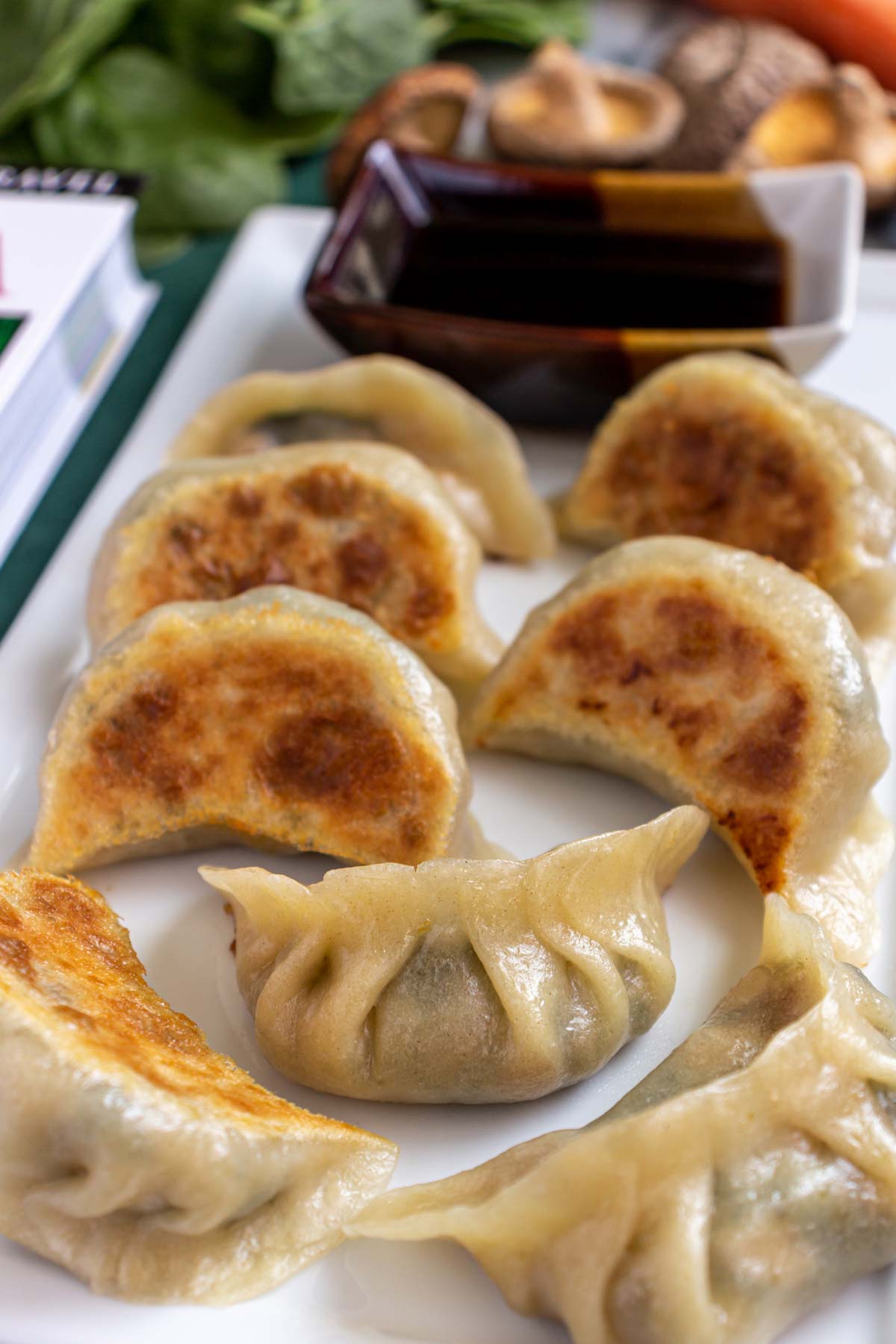
(This recipe was originally published in July 2011, but was updated with new photos and content in 2021).
Out of all the dumplings in my extensive dumpling recipe repertoire, these incredible vegetable dumplings are on my shortlist of favorites. These dumplings are not only vegetarian but actually vegan, but they have so much flavor you really won't miss the meat at all.
The crust on each dumpling is amazing! It's audibly crisp, yet perfectly balanced by the chewiness of the rest of the dumpling skin. Serving the dumplings with the crust facing up (or technically to the side) is vital in retaining the crisp texture.
I realize the recipe below may seem daunting, especially if it's your first foray into dumpling-making. You can easily make the filling and dough in advance, and can even assemble the dumplings hours before you plan on cooking them. Better yet, freeze them and then partially thaw them just in time for a dim sum party. A little patience will result in dumplings that are far worth the effort and time!
Ingredient notes
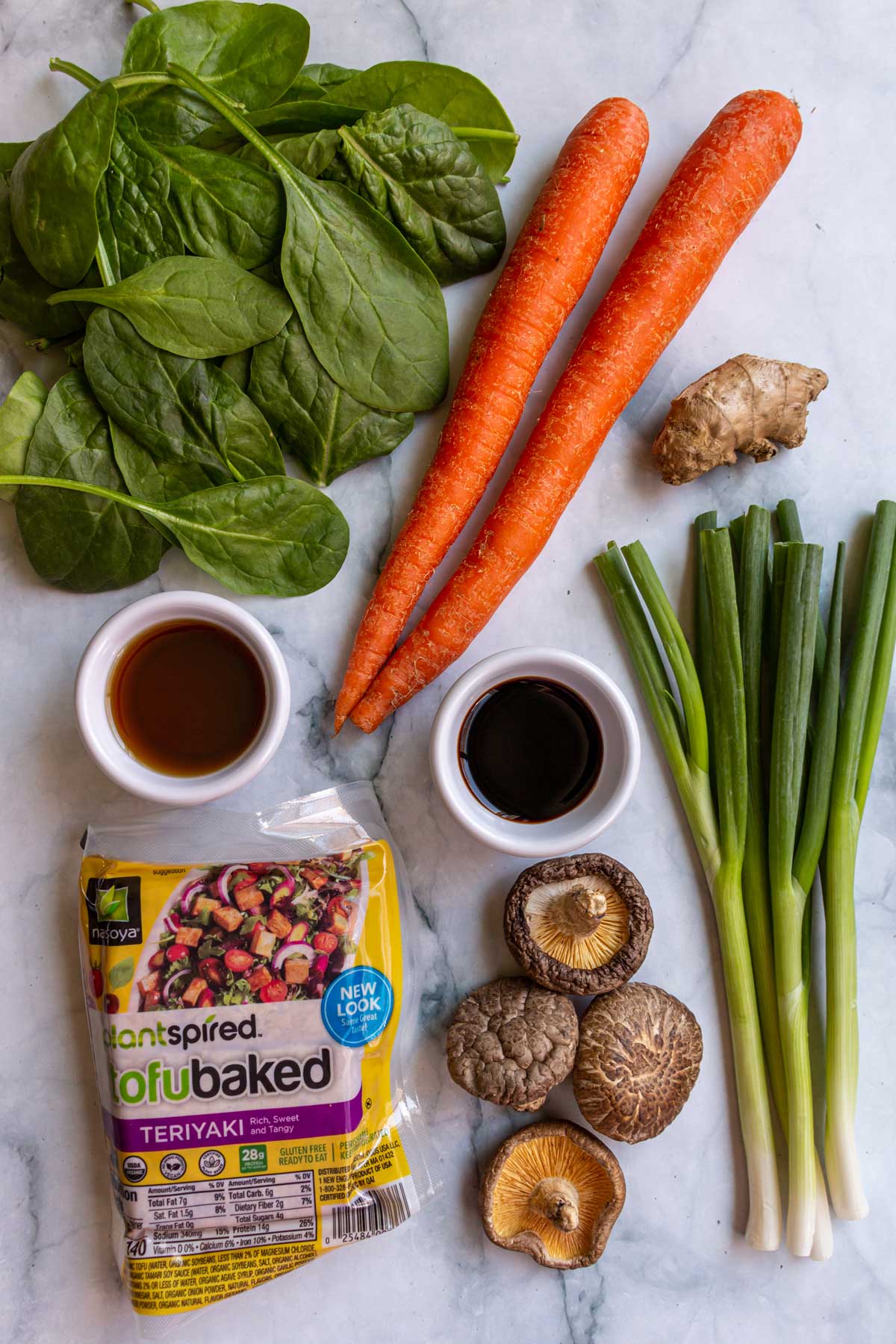
- Spinach: You may use regular or baby spinach for this vegan dumpling filling. If using regular spinach, make sure to pick through and discard any thick stems before chopping.
- Dried Shiitake Mushrooms: These are a workhorse in Chinese cuisine. They will last for a long time in your pantry and are very versatile in various Chinese recipes, like these Three Mushroom Dumplings. You'll get the best price for dried shiitake mushrooms at Asian markets, but they are also available at Whole Foods, specialty markets, and online.
- Baked Tofu: Also called pressed tofu, baked tofu is usually fairly dense because it has been marinated, pressed, and baked, which removes a lot of the water. It's sold in different flavors (I recommend the Teriyaki flavor for this recipe) from various brands. I have used Nasoya, WildWood, and Trader Joe's brands over the years, and they all work great in these vegetable dumplings. Each package (whether it's a 6 or 7-ounce package) will contain 2 blocks of baked tofu. Use 1 block for this recipe or double the recipe to use both. You can also freeze the remaining block for up to 3 months. I'm actually not a huge fan of tofu, but absolutely love these dumplings. It adds a meatiness and heartiness to the filling.
- Toasted Sesame Oil: The filling for these vegetarian potstickers gets a flavor boost from toasted sesame oil. This ingredient really takes the filling to another level so don't skip it. Store your toasted sesame oil in a cool, dry place away from light. Like many other oils, it can go rancid if not stored properly.
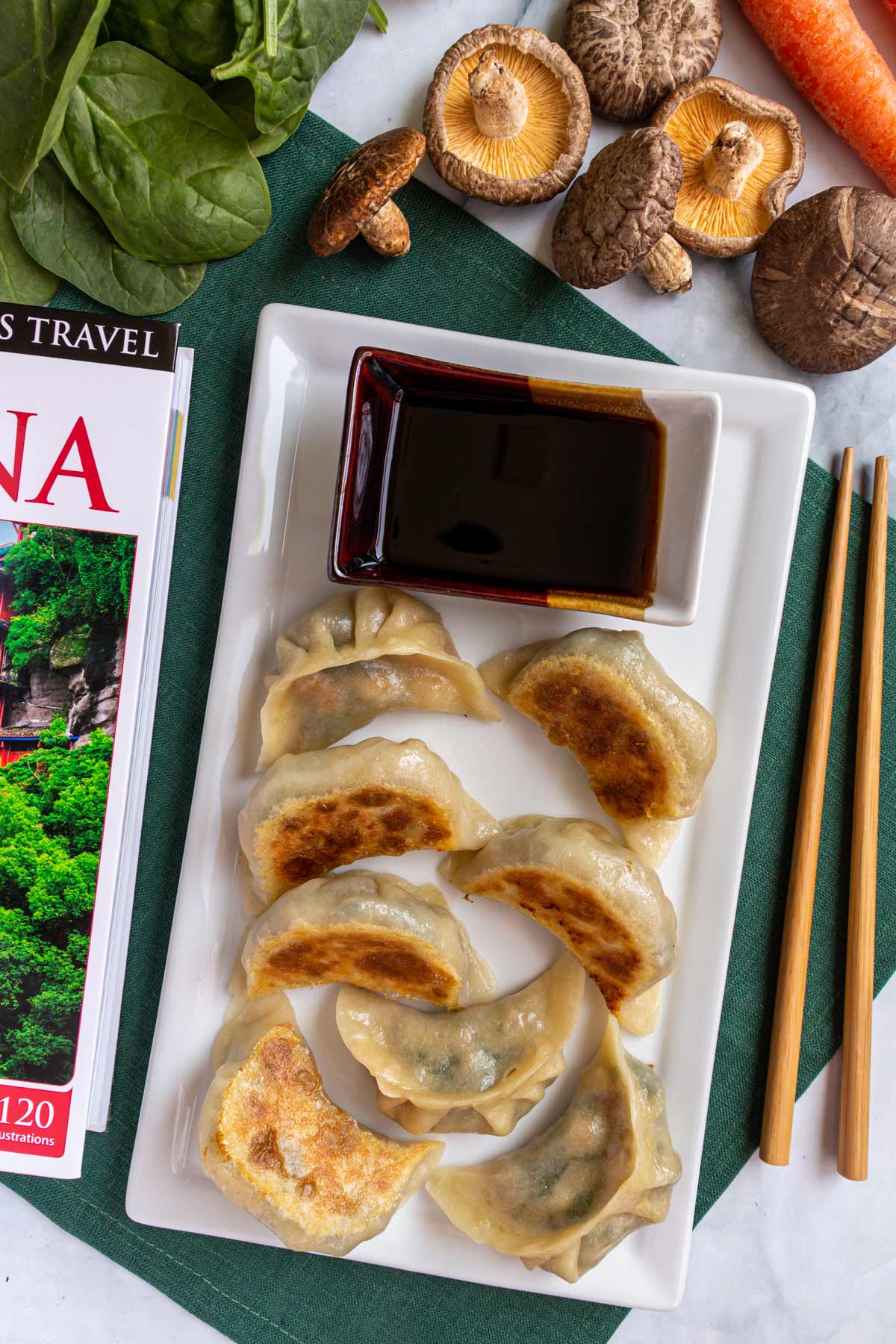
How to make the filling
Soak the dried mushrooms in a bowl with room temperature water to cover for 8 hours to overnight. Reserve most of the mushroom soaking liquid. Squeeze the mushrooms to remove residual liquid, cut off the tough stems, and finely chop the caps.
Put the chopped spinach in a large bowl and cover with boiling water. Wilt for about 30 seconds, drain, rinse with cold water, and drain again. Squeeze with your hands over the sink to remove excess moisture.
Make the flavoring sauce by combining ¼ cup of the reserved mushroom soaking liquid, sesame oil, soy sauce sugar, salt, and pepper. Stir to dissolve sugar and set aside. In another small bowl combine the cornstarch and 1 tablespoon reserved mushroom soaking liquid. Set aside.
In a wok or large skillet, heat oil. Add minced ginger and stir-fry for about 30 seconds until aromatic. Add the spinach, carrot, mushrooms, and pressed tofu. Stir to combine and then pour in the flavoring sauce. Cook until the vegetables release their juices a bit, give the cornstarch mixture a final stir and add it to the filling. Stir to thicken, remove from the heat and add the Chinese chives or scallions.
Transfer to a bowl and cool completely before assembling dumplings. You will have about 2 cups filling.
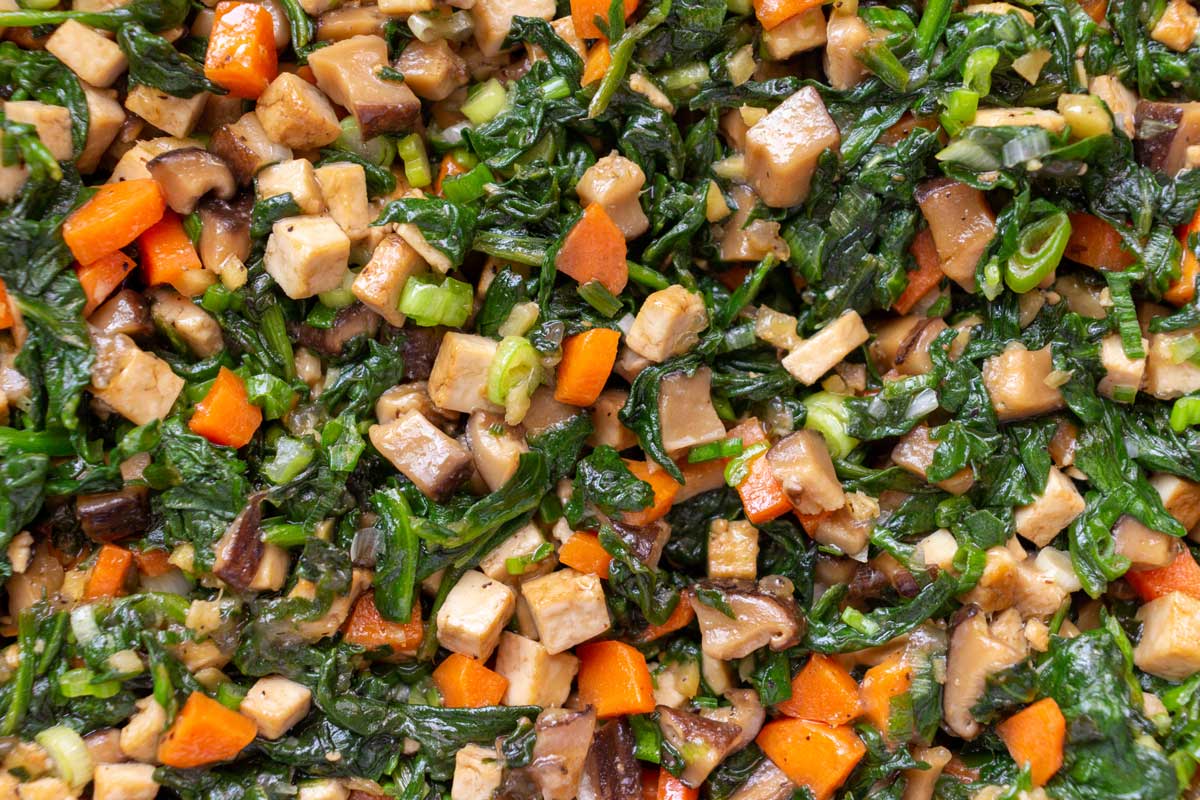
How to make the dough
Add flour to a large mixing bowl and make a well in the center. Use a wooden spoon to mix the flour while you add boiled water in a steady stream. Mix together until you have a lot of lumpy bits, then knead the hot dough in the bowl until the dough comes together. Add water by the teaspoon if the dough does not come together.
Continue kneading the dough until it's smooth and elastic. The dough should bounce back when pressed with your finger, but leave a light impression of your finger.
Place dough in a zip-top bag, seal tightly, pressing out excess air, and set aside at room temperature for 15 minutes up to 2 hours. The dough will steam up the bag and soften. After resting, the dough can be used right away, or refrigerated overnight and returned to room temperature before using.
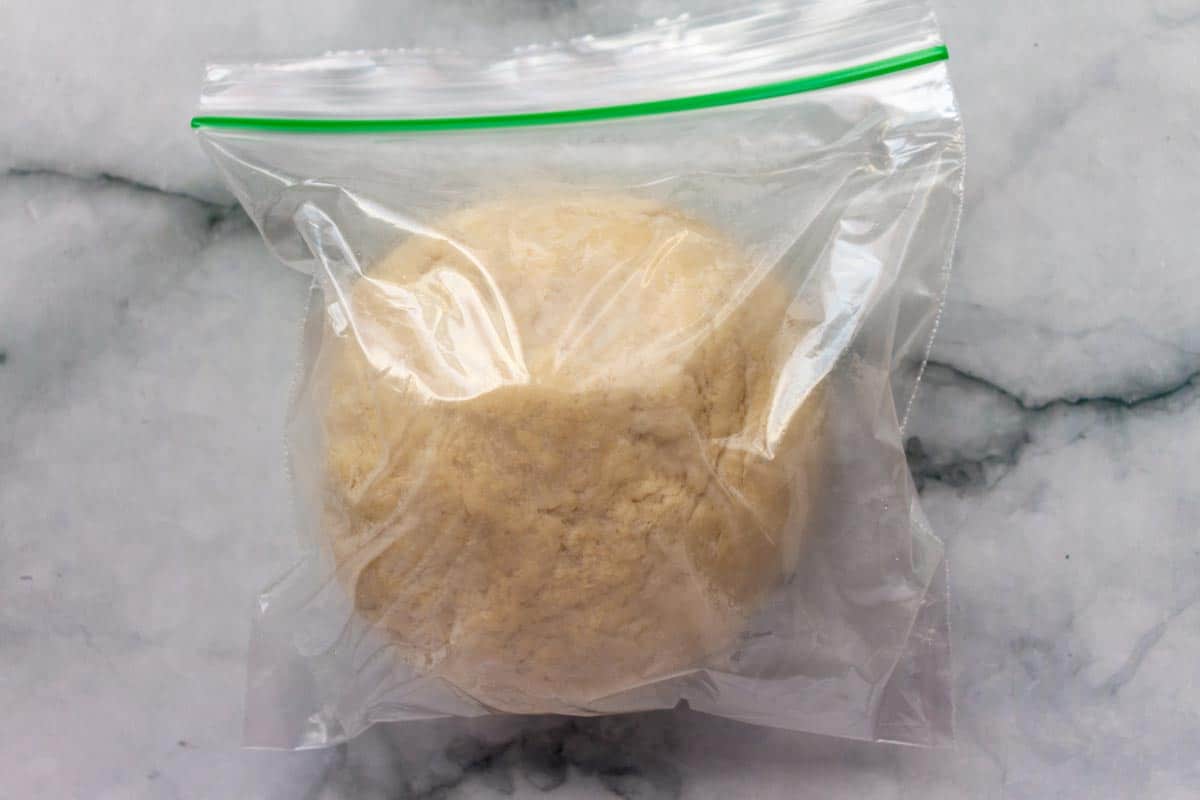
How to assemble
Remove the dough from the bag and cut it in quarters. Put ¾ back in the bag, squeezing out the air and sealing it closed to prevent drying.
Roll the dough into a 1-inch-thick log and cut into 8 pieces. Take each piece of dough and press each cut end in flour, lightly pressing the dough to about ¼ inch thick and set aside.
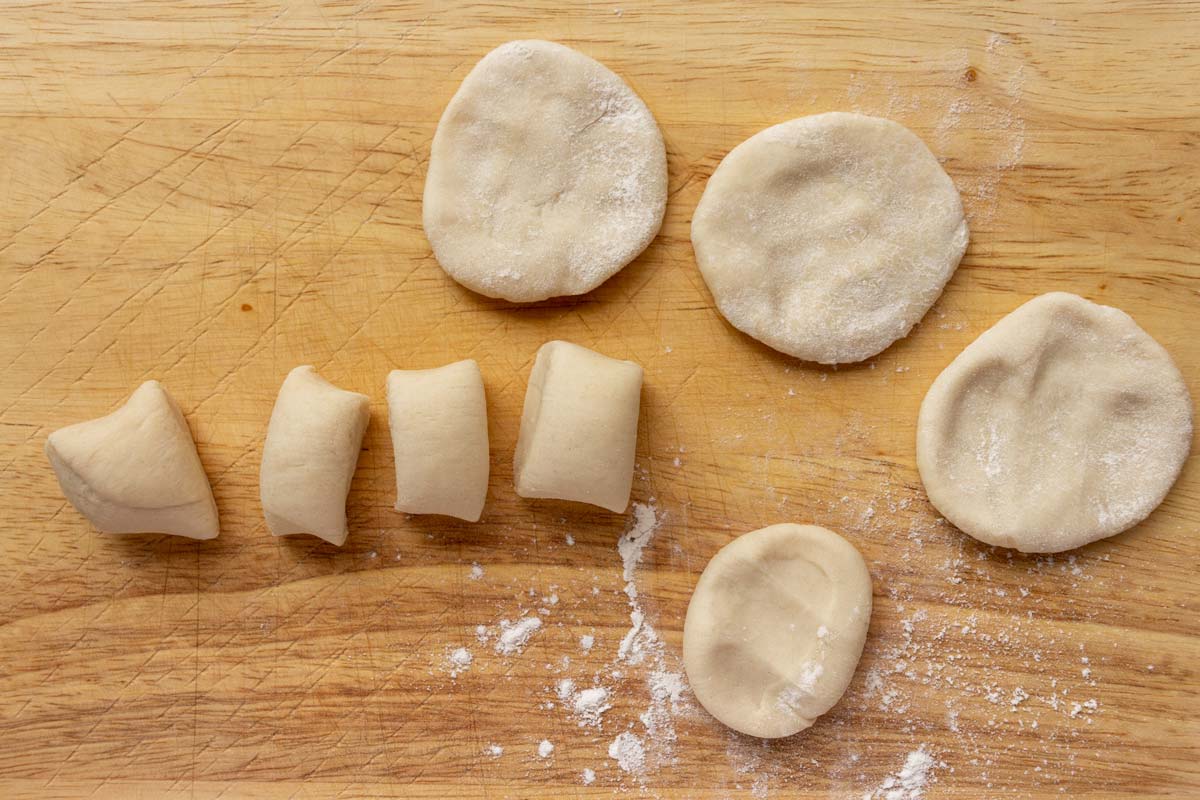
Next roll out each disk aiming for wrappers that are about 3 ¼ inches in diameter. When a batch of wrappers is formed, fill them before making wrappers out of the other portions of dough.
To assemble a dumpling, scoop about 1 tablespoon of filling into the center of the wrapper, pressing down gently to compact and keeping about ½ to ¾ inch of wrapper clear on all sides. Bring up the edges to seal into a half-moon shape or pleat the edges as desired.
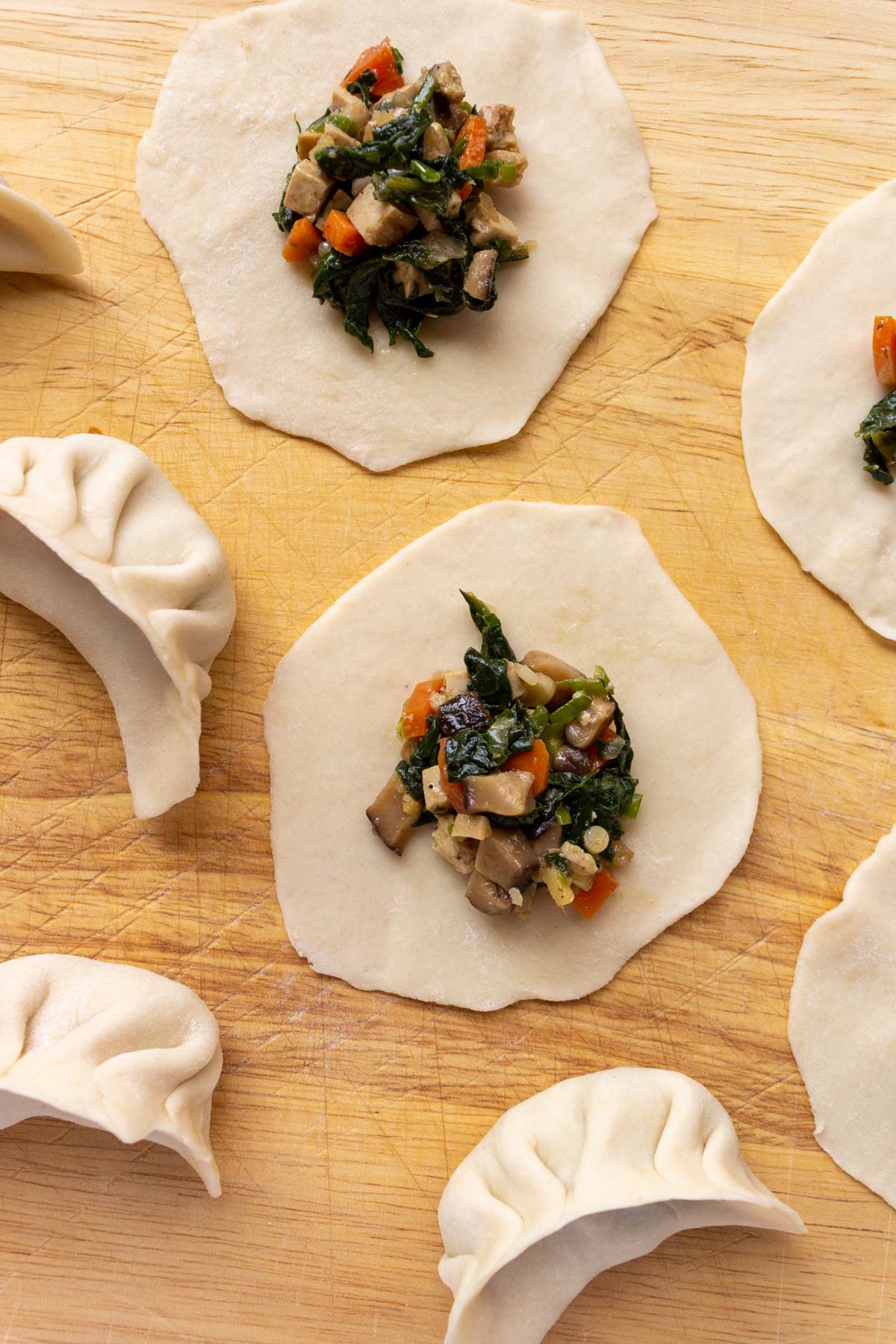
Place finished vegetable dumplings on a floured or parchment paper-lined baking sheet or cafeteria tray. Repeat with the remaining wrappers and dough, spacing out dumplings about ½ inch apart.
When all the veggie dumplings are assembled, they can be covered with plastic wrap and refrigerated for several hours and can be cooked straight from the refrigerator.
How to pan-fry
Use a medium or large nonstick skillet with a lid. Heat the skillet over medium-high heat and add a thin layer of oil. Place the dumplings 1 at a time, sealed edges up, in a winding circle pattern. The dumplings can touch. Fry the dumplings for 1 to 2 minutes until they are golden or light brown on the bottom.
Holding the lid close to the skillet to lessen splatter, use a measuring cup to add water to a depth of roughly ¼ inch (about ⅓ cup water). The water will immediately sputter and boil vigorously.
Cover with a lid, lower the heat to medium, and let the water bubble away for 8 to 10 minutes, until it is mostly gone. When you hear sizzling noises, remove the lid as most of the water is now gone. Let the vegetarian potstickers fry for another 1 or 2 minutes, or until the bottoms are brown and crisp.
Turn off the heat and wait until the sizzling stops before using a spatula to transfer dumplings to a serving plate. Display the vegetable dumplings with their bottoms facing up so they remain crisp. Serve with dipping sauce.
Please scroll to the bottom of the post for the full recipe (in a printable recipe card) including ingredient amounts and detailed instructions.
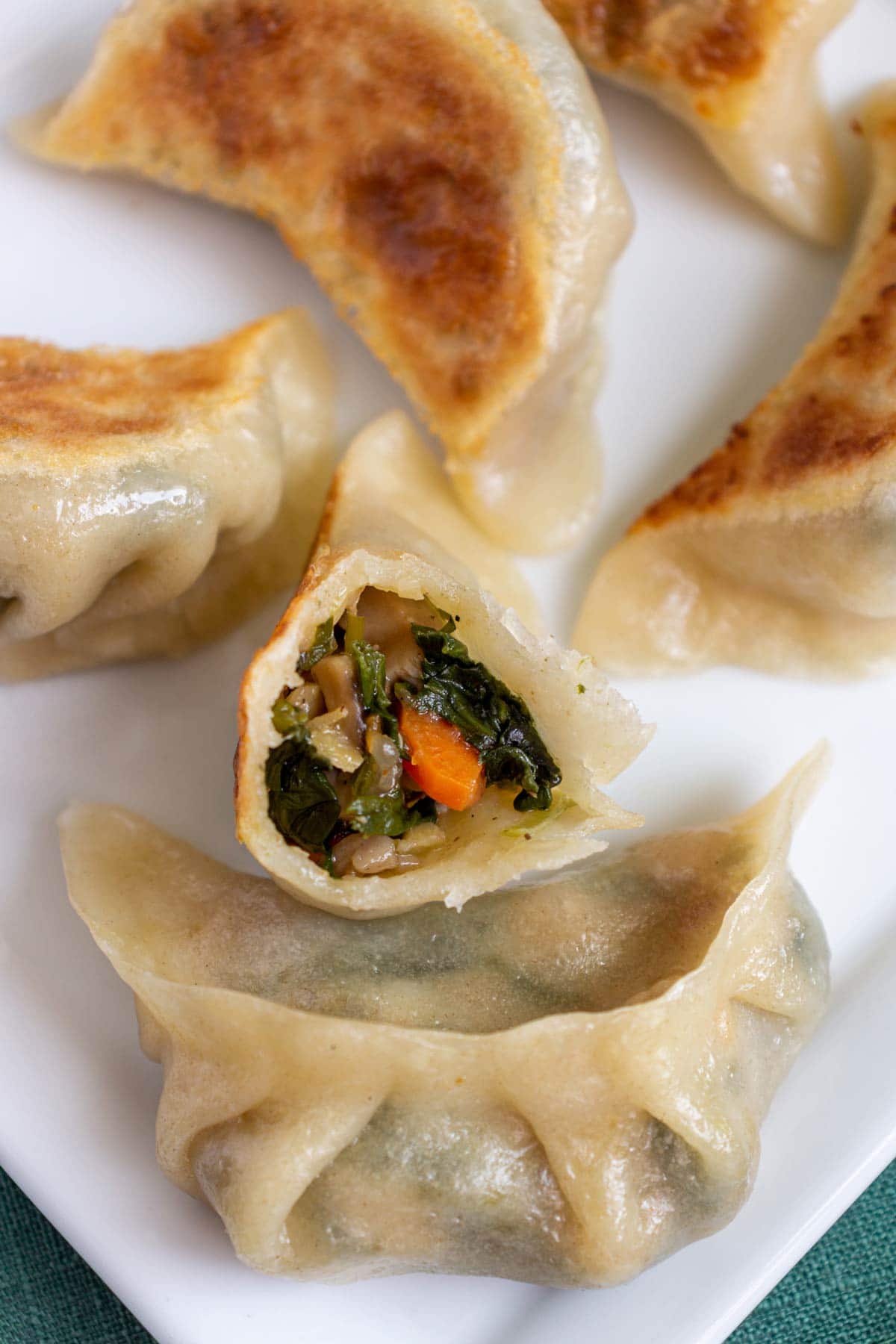
Expert tips and FAQ
Get a head start on these delicious vegan dumplings! The filling can be made in advance, covered and refrigerated up to one day ahead. Bring to room temperature before assembling dumplings.
Here are a couple easy ways to transform your simple white dumpling dough into colorful creations. For orange dough replace the just-boiled water with just-boiled 100% carrot juice. Meanwhile, for bright gold dough add 1 teaspoon ground turmeric into the flour before adding the water. The dough will develop its vibrant color as it sits. To make green dough follow the instructions in this Fish Dumplings recipe. Or perhaps try red dough by replacing the just-boiled water with just-boiled 100% tomato juice.
To make lighter pan-fried vegetable dumplings and avoid too much oil splatter, I like to spray a bit of avocado oil into my nonstick pan instead of drizzling. This uses a bit less oil but still evenly distributes it in the pan, yielding beautiful golden dumpling bottoms with a fraction of the fat and mess.
Yes, you may freeze assembled uncooked dumplings on their baking sheet until hard (about 1 hour). Then transfer frozen dumplings to a zip-top freezer bag, pressing out excess air before sealing, and freeze for up to 1 month. To cook after freezing, partially thaw, using your finger to smooth over any cracks that may have formed during freezing, before cooking.
Potstickers is a term used specifically for pan-fried dumplings. All potstickers are dumplings but not all dumplings are considered potstickers because dumplings can be cooked with different methods other than pan-frying.
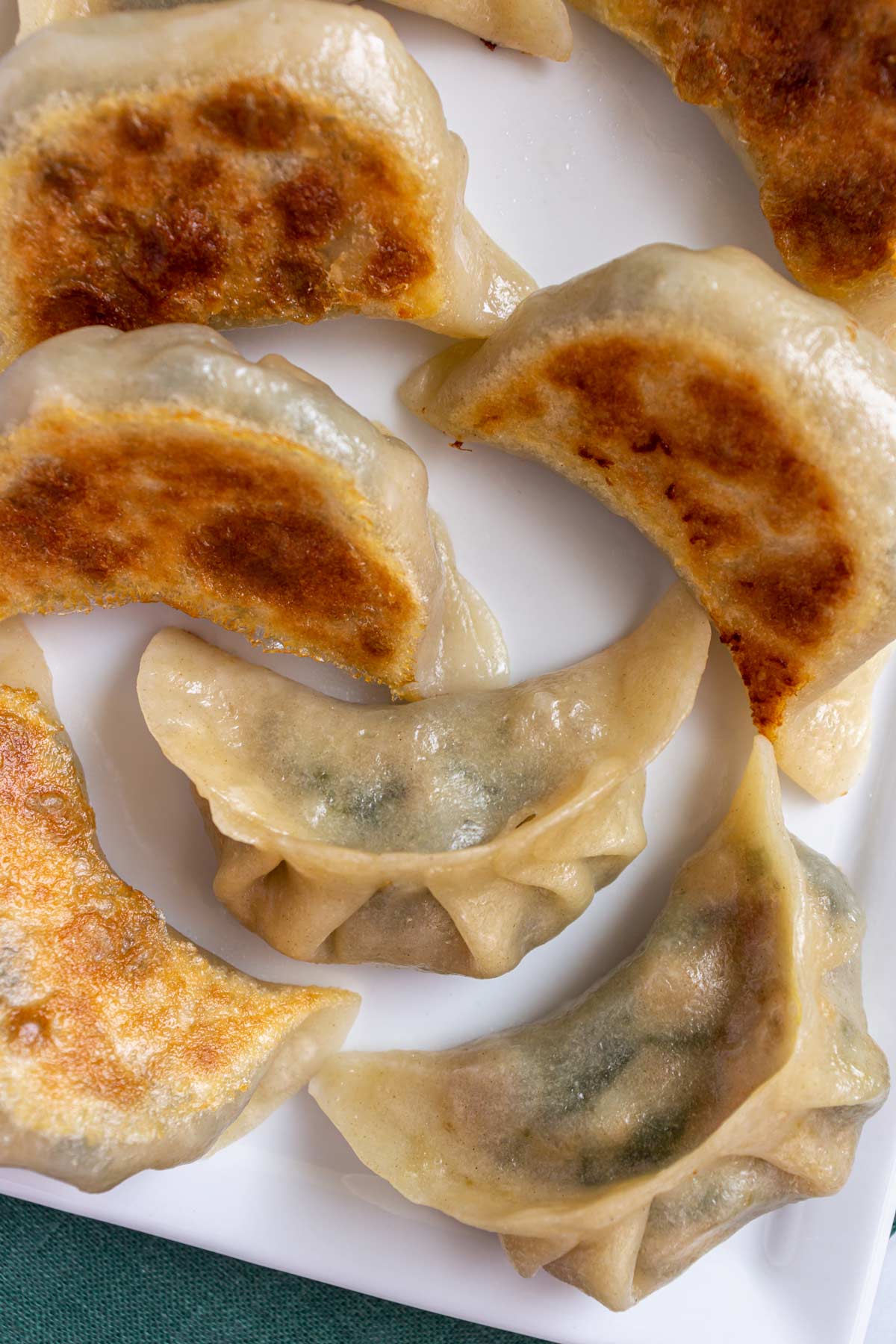
Other recipes you may like
- Three Mushroom Dumplings
- Vegan Edamame Dumplings
- Carrot Dumplings
- Brussels Sprouts and Bacon Dumplings
- Pea Shoots and Leek Dumplings
- Browse all Noodle and Dumpling Recipes
Tried this recipe? Please leave a star ⭐️⭐️⭐️⭐️⭐️ rating in the recipe card below and/or a review in the comments section further down the page. You can also follow me on social media on Facebook, Instagram, and Pinterest!
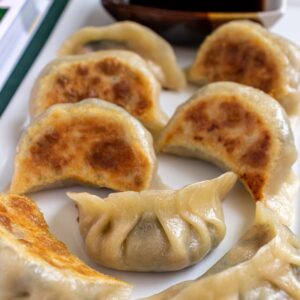
Pan-fried Vegetable Dumplings (Vegetable Potstickers)
Ingredients
Filling:
- 4 large dried shiitake mushrooms
- 4 cups lightly packed coarsely chopped regular or baby spinach (5 ½ to 6 ounces)
- 2 tablespoons toasted sesame oil
- 1 ½ tablespoons soy sauce
- ¾ teaspoon sugar
- ¼ teaspoon kosher salt
- ¼ teaspoon ground black pepper
- 1 tablespoon neutral flavored oil (such as vegetable or canola)
- 1 tablespoon finely minced fresh ginger
- 1 ½ ounces finely chopped carrot (⅓ cup)
- 3 to 3 ½ ounces pressed/baked tofu (half a 6 or 7-ounce package), finely chopped (⅔ cup to ¾ cup total)
- 2 teaspoons cornstarch
- ½ cup chopped Chinese chives or scallions (white and green parts)
Dough:
- 10 ounces (285 grams / 2 cups) all-purpose flour
- About ¾ cup just-boiled water (boil water, then let it sit for a minute off the heat before measuring)
Tangy Soy Dipping Sauce:
- ⅓ cup soy sauce
- 2 ½ tablespoons unseasoned rice, Chinkiang, or balsamic vinegar
- ⅛ teaspoon sugar, (optional)
- 1 tablespoon finely shredded ginger or 2 teaspoons finely minced garlic, (optional)
Cooking:
- Canola or peanut oil for pan-frying
Instructions
Filling:
- Soak the dried mushrooms in a bowl with room temperature water to cover for 8 hours to overnight (*see notes below*). Remove the mushrooms from their liquid. Reserve ¼ cup plus 1 tablespoon of the mushroom soaking liquid.
- Squeeze the mushrooms to remove residual liquid, cut off the tough stems, and finely chop the caps, resulting in about ½ cup chopped mushroom.
- Put the chopped spinach in a large bowl and cover with boiling water. Let spinach wilt for about 30 seconds, drain, rinse with cold water, and drain again. Squeeze spinach with your hands over the sink to remove excess moisture. You should have about ½ cup firmly packed spinach.
- In a small bowl, make the flavoring sauce by combining ¼ cup of the reserved mushroom soaking liquid, sesame oil, soy sauce sugar, salt, and pepper. Stir to dissolve sugar and set aside. In another small bowl combine the cornstarch and the remaining 1 tablespoon reserved mushroom soaking liquid. Set aside.
- In a wok or large skillet, heat the canola oil over medium to medium-high heat. Add the ginger and stir-fry for about 30 seconds until aromatic. Add the spinach, carrot, mushrooms, and pressed tofu. Stir to combine and then pour in the flavoring sauce. Cook for 2 minutes until the vegetables release their juices a bit, give the cornstarch mixture a final stir and add it to the filling. Stir to thicken, remove from the heat and add the Chinese chives or scallions.
- Transfer to a bowl and cool completely before assembling dumplings. You will have about 2 cups filling. The filling can be prepared 1 day in advance and refrigerated. Bring to room temperature before assembling dumplings.
Dough:
- Place a large mixing bowl over a damp paper towel on your work surface, to keep in place while mixing. Add the flour and make a well. Use a wooden spoon to mix the flour while you add the water in a steady stream. Mix together until you have a lot of lumpy bits, then knead the hot dough in the bowl until the dough comes together. Add water by the teaspoon if the dough does not come together.
- Continue kneading the dough on a lightly floured surface or in the mixing bowl if it's large enough (only flour if necessary, and do so sparingly) for a couple more minutes until the dough is smooth and elastic. The dough should bounce back when pressed with your finger, but leave a light impression of your finger.
- Place dough in a zip-top bag, seal tightly, pressing out excess air, and set aside at room temperature for 15 minutes up to 2 hours. The dough will steam up the bag and soften. After resting, the dough can be used right away, or refrigerated overnight and returned to room temperature before using.
Dipping Sauce:
- Combine the soy sauce, vinegar, and sugar and stir to dissolve. Taste and adjust flavors to your liking for a tart-savory balance. The sauce can be prepared several hours in advance up to this point. Right before serving, add the ginger or garlic if using.
Assembly:
- Remove the dough from the bag, turning the bag inside out if the dough is sticky. Put the dough on a lightly floured surface and cut it in quarters. Put ¾ back in the bag, squeezing out the air and sealing it closed to prevent drying.
- Roll the dough into a 1-inch-thick log and cut into 8 pieces (cut in half, then cut each half in half, and so on to create pieces that are even in size. The tapered end pieces should be cut slightly larger). If your pieces are oval, stand them on one of the cut ends and gently squeeze with your fingers to make them round, like a scallop. Take each piece of dough and press each cut end in flour, lightly pressing the dough to about ¼ inch thick and set aside.
- Next, flatten each dough disk into a thin circle, about ⅛ inch thick, either with a tortilla press (lined with plastic wrap), or with a heavy flat-bottomed object like a frying pan (also lined with plastic). Alternatively, use a dowel (which is a good lightweight rolling pin alternative for fast and flexible dumpling making) to lightly roll out each disc into an ⅛ inch thick circle.
- To finish the wrappers, place wrappers one at a time on your work surface, and flour only if sticky. Imagine a quarter-size circle in the center of the dough. This is what the Chinese call the “belly” of the wrapper. You want to create a wrapper that is larger than its current size, but still retaining a thick “belly” in the center. This ensures an even distribution of dough when the dumpling is sealed. Use the rolling pin to apply pressure to the outer ½-to-¾-inch border of the wrapper. Roll the rolling pin in short downward strokes with one hand while the other hand turns the wrapper in the opposite direction. Aim for wrappers that are about 3 ¼ inches in diameter. When a batch of wrappers is formed, fill them before making wrappers out of the other portion of dough.
- Line a baking sheet with parchment paper or dust generously with flour. To assemble a dumpling, scoop about 1 tablespoon of filling into the center of the wrapper, pressing down gently to compact and keeping about ½ to ¾ inch of wrapper clear on all sides. Bring up the edges to seal into a half-moon shape or pleat the edges as desired.
- Place finished dumplings on the prepared baking sheet. Repeat with the remaining wrappers and dough, spacing out dumplings about ½ inch apart. Keep the finished dumplings covered with a dry kitchen towel.
- When all the dumplings are assembled, they can be covered with plastic wrap and refrigerated for several hours and can be cooked straight from the refrigerator.
Cooking:
- To pan-fry the dumplings, use a medium or large nonstick skillet with a lid. Heat the skillet over medium-high heat and add 1 ½ tablespoons oil for a medium skillet and 2 tablespoons for a large one. Place the dumplings 1 at a time, sealed edges up, in a winding circle pattern. The dumplings can touch. Fry the dumplings for 1 to 2 minutes until they are golden or light brown on the bottom.
- Holding the lid close to the skillet to lessen splatter, use a measuring cup to add water to a depth of roughly ¼ inch (about ⅓ cup water). The water will immediately sputter and boil vigorously. Cover with a lid or aluminum foil, lower the heat to medium, and let the water bubble away for 8 to 10 minutes, until it is mostly gone. When you hear sizzling noises, remove the lid as most of the water is now gone. Let the dumplings fry for another 1 or 2 minutes, or until the bottoms are brown and crisp. Turn off the heat and wait until the sizzling stops before using a spatula to transfer dumplings to a serving plate. Display them with their bottoms facing up so they remain crisp.
- Serve with the dipping sauce and enjoy!
Notes
- Although slow soaking the dried shiitake mushrooms overnight is ideal and will result in the best texture and flavor, if you haven't planned ahead you can cover with hot water instead of room temperature. Let them stand for 30 to 45 minutes to soften before proceeding.
- Freeze the assembled uncooked dumplings on their baking sheet until hard (about 1 hour), transfer to a zip-top freezer bag, pressing out excess air before sealing, and frozen for up to 1 month. To cook after freezing, partially thaw, using your finger to smooth over any cracks that may have formed during freezing, before cooking.
- Here are a couple easy ways to transform your simple white dumpling dough into colorful creations. For orange dough replace the just-boiled water with just-boiled 100% carrot juice. For bright gold dough add ¾ teaspoon ground turmeric into the flour before adding the water. The dough will develop its vibrant color as it sits. For green dough follow the instructions in this Fish Dumplings recipe. Or perhaps try red dough by replacing the just-boiled water with just-boiled 100% tomato juice.
- To lighten my veggie potstickers and avoid too much oil splatter, I like to spray a bit of avocado oil into my nonstick pan instead of drizzling. This uses a bit less oil but still evenly distributes it in the pan, yielding beautiful golden dumpling bottoms with a fraction of the fat and mess.
- If you prefer steamed veggie dumplings: place the dumplings into a bamboo steamer lined with a perforated parchment circle or cabbage leaves (to keep the dumplings from sticking to the steamer) steam over boiling water for for about 8 minutes, or until slightly puffed and somewhat translucent. Remove the trays and place each atop a serving plate.
- Adapted from Asian Dumplings
Nutrition
*All nutritional information is based on third-party calculations and should be considered estimates. Actual nutritional content will vary with brands used, measuring methods, portion sizes and more.*







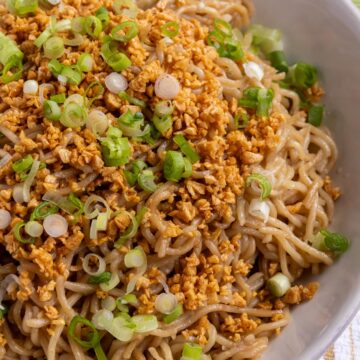
Comments
No Comments